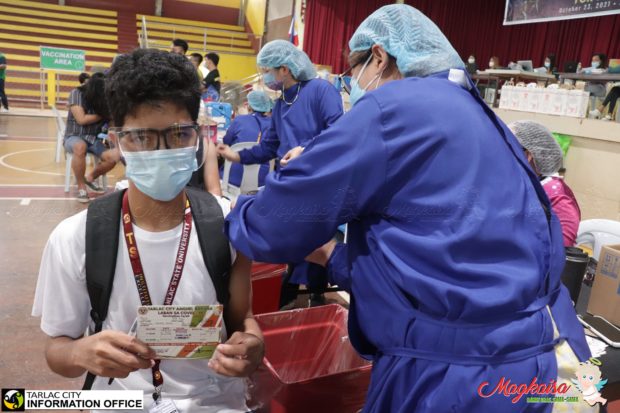COVID positivity rate under WHO mark for 2 consecutive days

FILE PHOTO Health workers conduct free swab tests in Manila about a month before the easing of the quarantine restrictions. —RICHARD A. REYES
MANILA, Philippines — Vaccination, testing and contact tracing outside Metro Manila should be ramped up to sustain the “gains” achieved so far in the country’s fight against COVID-19, said independent pandemic monitor OCTA Research.
OCTA Research was referring to the decline in the COVID-19 positivity rate, referring to the number of people infected among tested individuals, to well within the World Health Organization (WHO) benchmark of 5 percent or less.
The Department of Health (DOH) reported on Thursday a positivity rate of 4.9 percent, still within the WHO benchmark for the second straight day. This means that of the 43,357 people tested, 2,124 came out positive for the virus.
However, Ranjit Rye of OCTA Research noted at a press briefing that the country had yet to achieve its vaccination targets and that the government should focus on the provinces as the pace of inoculation across the country, except in the National Capital Region (NCR), remained slow.
“OCTA’s constant recommendation is for the government to sustain expanded tracing, testing and isolation. Also, we focus a lot on NCR and places like Metro Davao and Cebu … Vaccination is very high in NCR, but quite low everywhere else,” Rye told reporters on Thursday.
Article continues after this advertisement“We still have a long way to go. Only 35 percent of the target adult population have been fully vaccinated. So we’re not yet where we are supposed to be. There’s so much that needs to be done as far as vaccination is concerned,” he added.
Article continues after this advertisementVaccination still slow
Based on the Nov. 10 data from the national COVID-19 dashboard, 30.5 million Filipinos had been fully vaccinated, accounting for 36.5 percent of the eligible population, while 36.3 million had received their first jab.

A college student gets vaccinated against COVID-19 at the Tarlac State University’s gymnasium. (Photo courtesy of the Tarlac City Information Office)
By region, Metro Manila led with 88.1 percent of the target population fully vaccinated as of Nov. 2, while the rest of the regions are lagging way behind with vaccination rates of 39 percent and below.
The Bangsamoro Autonomous Region in Muslim Mindanao placed last with immunization coverage of only 9.8 percent.
OCTA reported that NCR’s positivity rate was already down to 3 percent as of Nov. 10, the lowest since testing started during the pandemic. Positivity rates in the cities of Cebu and Davao are also down to 2 percent and 5 percent, respectively.
Contract tracing improves
The WHO said a positivity rate of below 5 percent should be maintained for at least 14 days, the maximum incubation period, to indicate that COVID-19 was contained in the country.
Contact tracing efficiency, improved to a ratio of 1:30 in Metro Manila, said Guido David, another OCTA Research fellow. This means that for every case detected, 30 close contacts are traced.
“Contact tracing is good right now. And the level of testing is appropriate for the population, at least in the NCR,” David said at the same press briefing.
In May, the National Task Force Against COVID-19 lowered its contact tracing standard to a more “realistic” 15 contacts per patient from the original standard of 1:37. That was when actual contact tracing ratio was only about 1:7.
Rye said the budget for contact tracing should be sustained until next year as it was expected to be depleted soon.
“We can’t have contact tracing without paying contact tracers. It’s an activity that’s heavy on specialized manpower. The government needs to pay for this,” Rye said.
However, the proposed budget for next year does not include any allocation for contact tracing. Virus case update
In the meantime, the DOH said new daily infections slipped to 1,974, down from the previous day’s record of 2,646. This pushed the number of cases to 2,811,248.
Of the total 28,660 active cases, the majority, or 62.1 percent, had mild symptoms.
There were 2,388 new survivors who were added to the total recovery count of 2,737,722.
The death toll increased to 44,866 after 142 more fatalities were recorded.